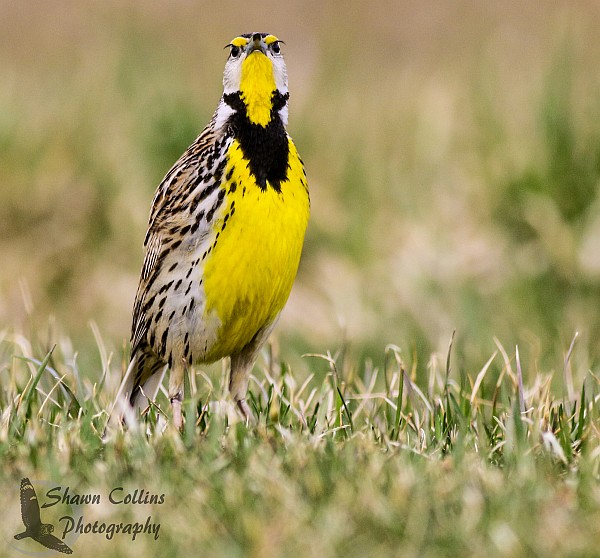
Just back from migration, this eastern meadowlark looks like he’s annoyed at the world.
Shawn Collins captured his expressive moment at Pymatuning State Park on April 8.
(photo by Shawn Collins)

Just back from migration, this eastern meadowlark looks like he’s annoyed at the world.
Shawn Collins captured his expressive moment at Pymatuning State Park on April 8.
(photo by Shawn Collins)
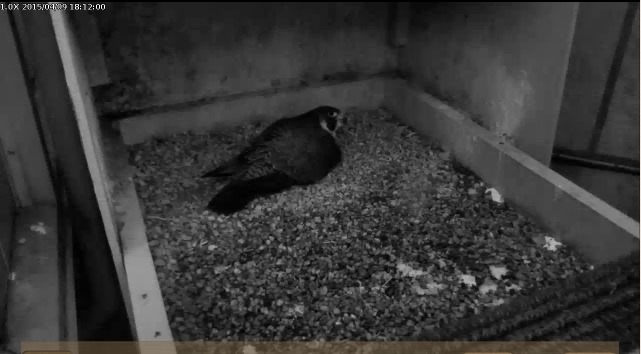
BREAKING NEWS AT 1:45PM, APRIL 10!
The streaming camera is up again thanks to Bill Powers from PixController & Phil Hieber at University of Pittsburgh.
THIS MORNING AT 7:15AM I WROTE:
The sun sets close to 8:00pm in Pittsburgh now, yet it was dark last night at 6:12pm in this image from the Cathedral of Learning falconcam. You can’t see the lightning or hear the thunder but at this moment E2 is watching a severe thunderstorm crashing around him. Soon it began to hail.
And at 6:12:54 PM the camera went down. The live video went dead.
Lightning can do crazy things. Bill Powers of PixController hopes a reboot of the streaming camera will revive it (i.e. turning it off/on indoors). If not, we’ll have wait until the nesting season is over this summer to fix it.
I know what you’re thinking. No, we cannot go out on the ledge to fix the camera. These are endangered birds, protected by the PA Game Commission, and it’s forbidden to disturb them and their nests. Besides, it would be counter productive. If the fix worked you’d get a nice camera image but the peregrines would quit nesting and there’d be nothing to watch. And an outdoor fix might not work. If the damage is electrical it’ll require a whole new camera.
The good news is that the Pitt snapshot camera is working though it has no sound and doesn’t stream video. You can see its snapshots every 10-15 seconds here.
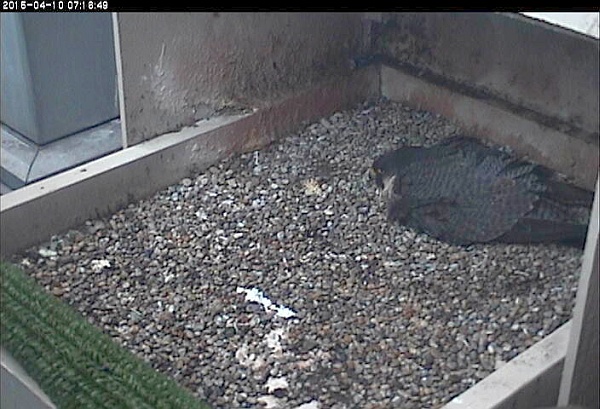
Dorothy and E2 will continue to incubate their eggs and we’ll see what happens when they’re due to hatch in early May.
Just because we can’t see something streaming live on the Internet doesn’t mean it isn’t happening. 🙂
(photos from the National Aviary falconcams at University of Pittsburgh)
At 2:02pm Dorothy laid her fourth egg.
She looks tired. Now she can rest!
LATER: Here’s the entire Pitt peregrine family at 4:39PM.

(photos from the National Aviary snapshot cam at University of Pittsburgh)
9 April 2015
Last night we learned about nests on PBS NATURE‘s Animal Homes. Next Wednesday Episode 2 will take us inside bird and mammal homes chosen for their prime locations. Tune in at 8:00pm EDT to learn:
Watch Animal Homes: Location, Location, Location on PBS NATURE, April 15 at 8:00pm EDT. In Pittsburgh it’s on WQED.
(video from PBS Nature, Animal Homes Episode 2, Location, Location, Location)
Though all eyes are on Dorothy and E2 at the Cathedral of Learning, there are up to 10 other peregrine sites in the Pittsburgh area. Here’s all the news.
Cathedral of Learning, University of Pittsburgh:
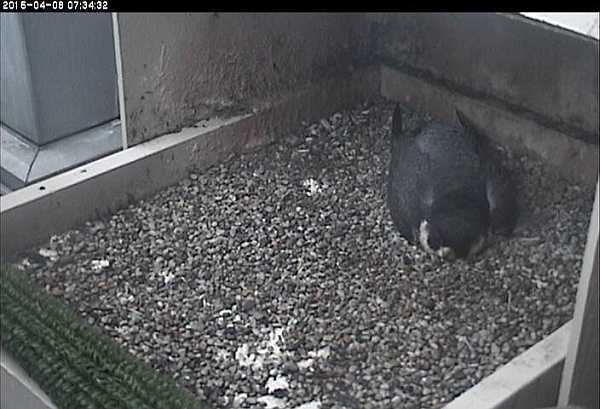
The Big Sit begins: Except for a few standing-up moments, it appears Dorothy began incubation yesterday so we can expect her eggs to hatch around May 10 if they are viable. In the meantime she’s now a media star for having laid three eggs at age 16 after her egg bound episode last spring. Click on these links to read about her third egg, learn what egg bound means, and why those of us who know her can see that she’s showing her age.
Westinghouse Bridge:
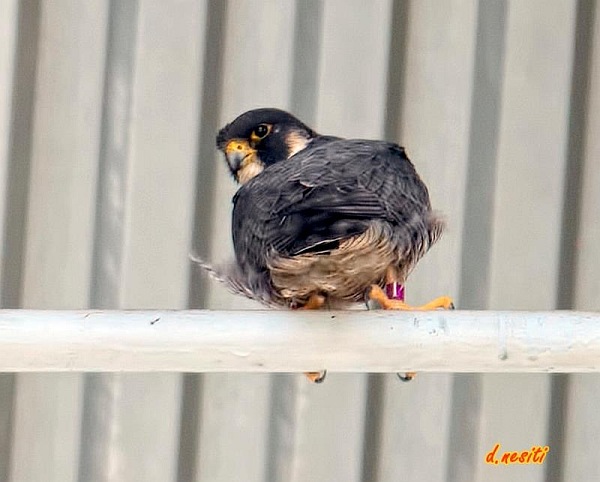
Peregrines have nested at the Westinghouse Bridge since at least 2010 but can be hard to find. Volunteer monitor John English solved this problem by introducing local peregrine fans to the site and they have helped. Dana Nesiti photographed the female on April 4 and confirmed she’s still Hecla, born at the Ironton-Russelton Bridge, Ohio in 2009. Then on April 6 Dave Kerr heard a peregrine calling and watched as it presented prey to Hecla on the catwalk. The nature of that exchange indicates she’s on eggs. Yay!
I-79 Neville Island Bridge:
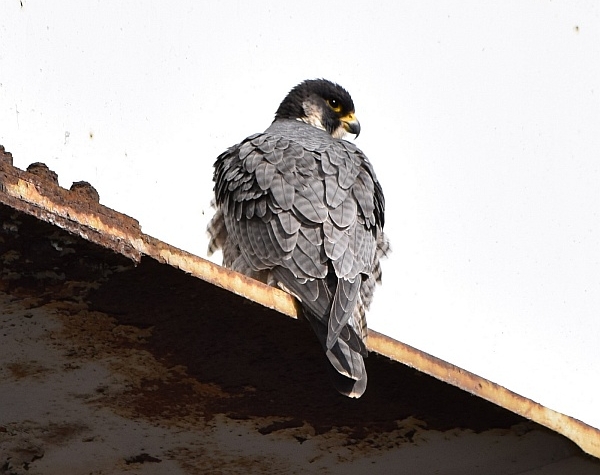
In 2012 we learned that peregrines were nesting at the I-79 Neville Island Bridge when one of their young was found swimming in the Ohio River. Last year a similar mishap probably killed their lone nestling who went missing after a bad storm. But, so far so good this year. Anne Marie Bosnyak has seen the pair calling, mating, and exchanging prey and their behavior now indicates they are probably incubating eggs. Anne Marie confirmed that the female is Magnum, hatched at Bank One, Canton, Ohio in 2010. The male is still unidentified.
Tarentum Bridge:
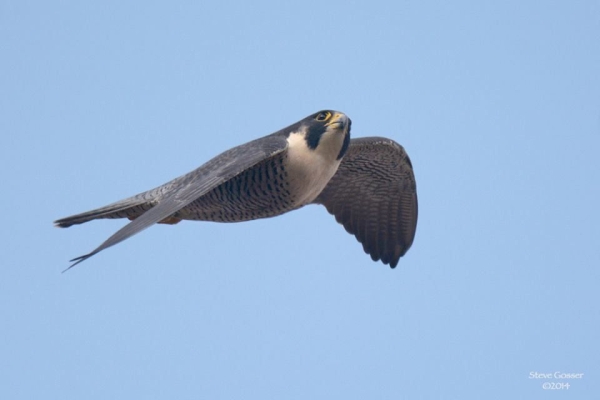
Hope from Hopewell, Virginia (2008) has made the Tarentum Bridge her home since 2010. Rob Protz checks on her every week — sometimes several times a day — but she is quite skilled at avoiding detection. Rob saw her eating prey on Easter Day but he couldn’t see where she went when she flew under the New Kensington side of the bridge. Last year’s nest site was so inaccessible that the PA Game Commission installed a nestbox for her this winter. She doesn’t seem to be using it yet.
Elizabeth Bridge: NEW SITE?
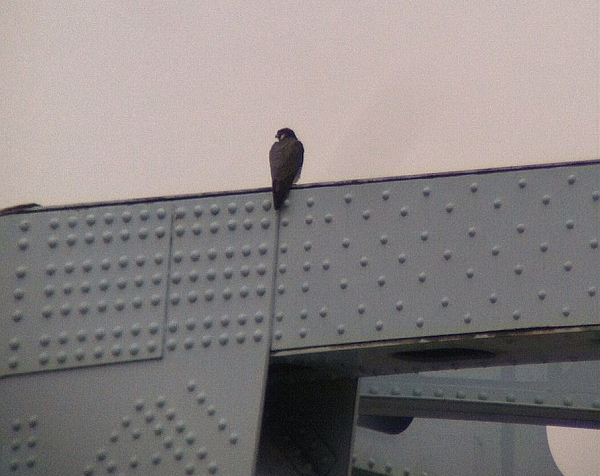
Imagine Jim Hausman’s surprise when he examined his photos of a peregrine on the Elizabeth Bridge and found out there were actually two! This bridge over the Monongahela River hasn’t been on our radar as a peregrine nest site but now it is. Jim keeps checking but hasn’t seen any peregrines there again. However, these birds are notoriously sneaky when they’re nesting so they might be at the Elizabeth Bridge, just keeping a low profile. If so, this site would be the ninth location in our metro area.
Downtown Pittsburgh:
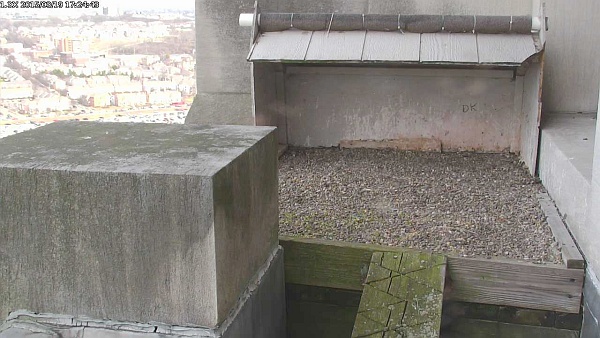
Speaking of sneaky peregrines, the downtown peregrines have abandoned the Gulf Tower again but are still nesting in the city center. At Peregrine Quest on March 22 we saw peregrines Downtown, could tell by their behavior that they were probably nesting, but did not get a hint at their nest location. Later Heather Jacoby made several trips to their last known sighting — 9th Street at Liberty Avenue — but came up empty though she saw them flying by. The pair is Downtown but they’re not letting us know where. If you see them, please leave a comment to let us know!
Highland Park area: Solo Peregrine
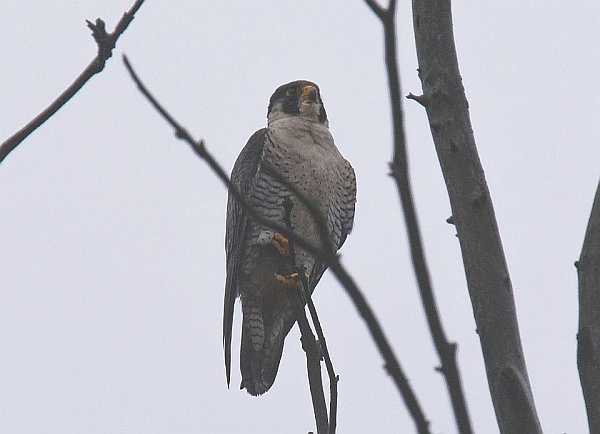
For a week in mid-March, Maury Burgwin saw and photographed this peregrine in the Highland Park area. If it had stayed in Pittsburgh it could have made a tenth peregrine site, but it was alone and it hasn’t been seen lately. Perhaps it moved on.
And finally, these three sites are mysteries:
(photo credits:
Cathedral of Learning: Dorothy and 3 eggs from the National Aviary falconcam at the University of Pittsburgh. Click on the image to watch the live feed.
Westinghouse Bridge: peregrine female, Hecla, by Dana Nesiti
I-79 Neville Island: peregrine female, Magnum, by Anne Marie Bosnyak
Tarentum Bridge: peregrine female, Hope, by Steve Gosser
Elizabeth Bridge: unidentified peregrine by Jim Hausman
Highland Park area: unidentified peregrine photographed by Maury Burgwin)
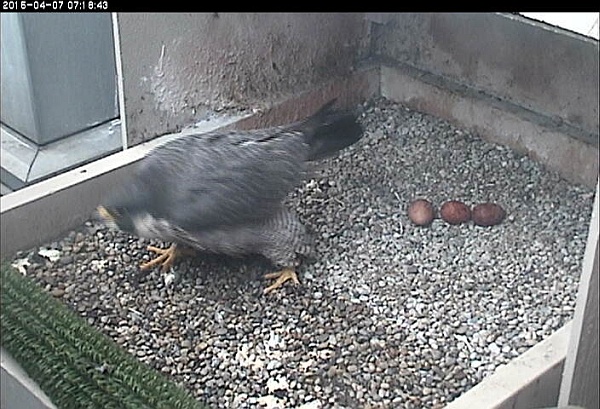
Dorothy laid her third egg this morning at 4:04am. In this snapshot, she’s leaving to eat breakfast.
She paused on the front perch …
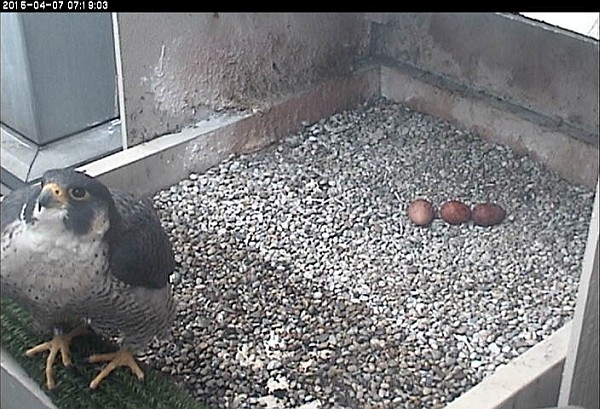
…and E2 came into the picture to cover the eggs.
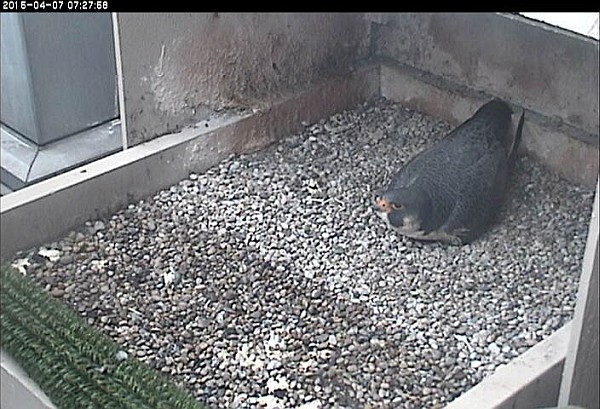
At 16 years old, every egg is a miracle for this matriarch peregrine falcon. Her second egg on April 4 spawned a follow-up Post-Gazette article and a video on KDKA. Her celebrity is growing.
(photo from the National Aviary falconcam at University of Pittsburgh. Click on the image to watch the live feed)

Spring is off to a slow start this year. Last month I predicted coltsfoot would bloom in March but it didn’t appear in Schenley Park until April 4. Since the city is always warmer than the countryside I’m sure many of you are still waiting for coltsfoot.
Despite my poor March prediction I’m going to make one for April. Maybe spring will “catch up” this month. If so, you can expect to find…
Here’s a taste of Spring to come.
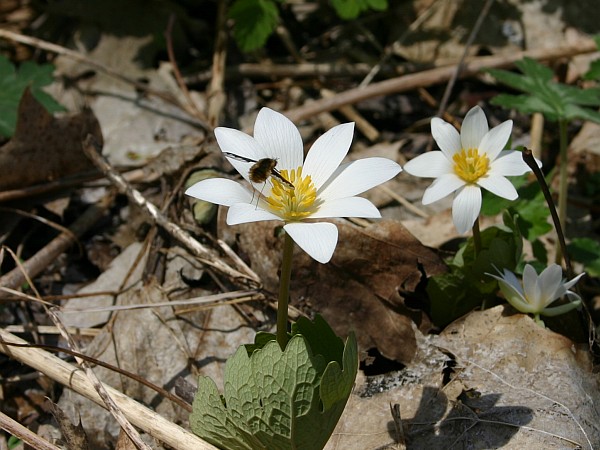
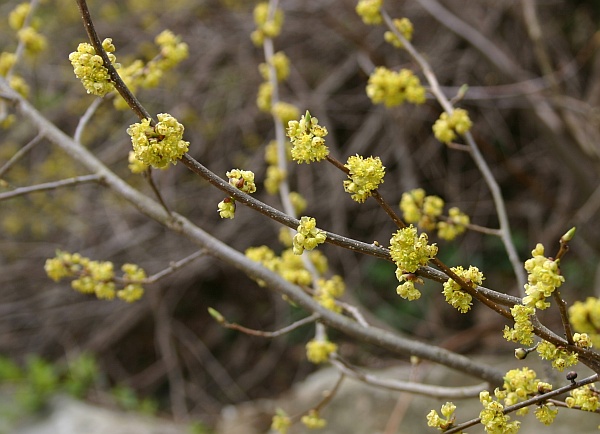
It’s a good month to be outdoors.
(photo credits: Yellow-throated warbler by Steve Gosser. Bloodroot and spicebush by Kate St. John)
p.s. Yellow-throated warblers are southern birds that are expanding their range northward. They’re in southwestern PA but not northern … yet.
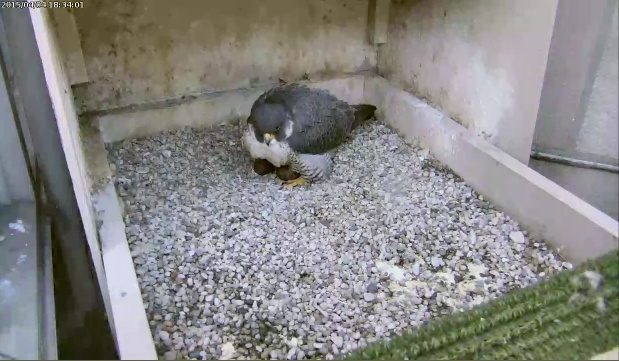
Yesterday morning Dorothy made news in the Pittsburgh Post-Gazette with an article about her miracle egg, laid at age 16 (click here to read).
Then yesterday afternoon at 3:33pm she performed another miracle and laid a second egg.
A year ago on this date she was recovering from being egg bound on egg#2 so she’s already doing better this year than last. Definitely a healthy sign.
Last evening I saw Dorothy shake open her brood patch and warm the eggs but …
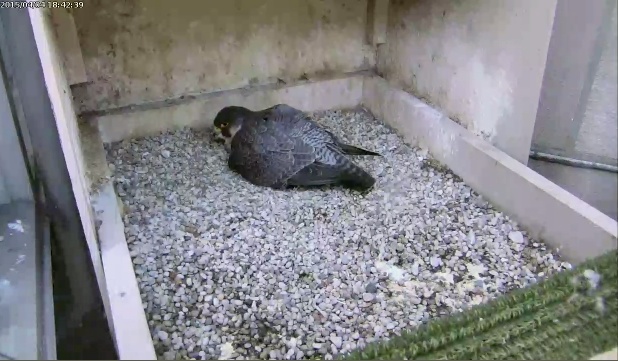
… this was not the start of incubation. It was only a temporary warming. As you can see from this overnight footage she isn’t incubating yet.
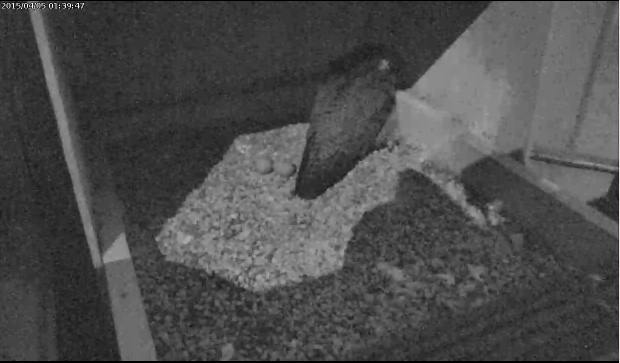
Peregrines begin incubation after the female lays her next-to-last egg. Technically the eggs hatch in 32 days but it’s hard to tell when incubation begins. (The textbooks used to say 33-35 days. )
Delayed incubation results in synchronous hatching. All the peregrine eggs hatch on the same day (except for the one laid after incubation began) and all the chicks are the same age. Peregrine nestlings do not compete with each other for food like bald eaglets do. There is no danger of siblicide.
The fact that she isn’t incubating means Dorothy thinks there’s another egg in her but we don’t know how many. We have no hatch date estimate yet.
(photos from the National Aviary falconcam at the University of Pittsburgh)
Last Tuesday afternoon the frogs at Raccoon Creek State Park Wildflower Reserve in Beaver County, PA were singing up a storm so I recorded them with my cell phone.
The loud peeps or “crrrreeeep” sounds are spring peepers. The low mutterings or quackings are wood frogs.
There are so many wood frogs in this audio that you can’t hear individuals. There are so few spring peepers that you can hear each one. There might be more species here but I don’t have the ear to hear them.
Check out this list of western Pennsylvania frogs for more possibilities.
(video recorded on March 31, 2015 by Kate St. John)
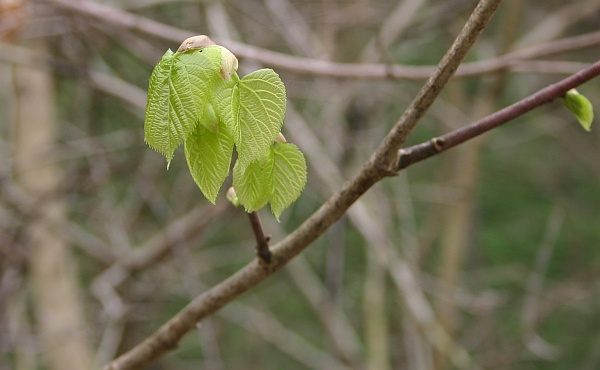
On a global scale, 2014 was the warmest year ever recorded but climate change is complicated on the local level. In Pittsburgh we’ve changed into yo-yo extremes.
Pittsburgh’s last two winters were colder than normal but three years ago it was really hot. Spring came six weeks late in 2014 and six weeks early in 2012. This photo of leaves opening on March 25, 2012 is impossible during this year’s cold spring.
I noticed the changes in 2012 but wouldn’t have remembered them if I hadn’t taken a picture. That’s the beauty of keeping a nature journal and it caught the attention of climate journalist Julia Kumari Drapkin. She noticed that local experience of climate change is ahead of the science curve and often raises interesting questions so she decided to flip the typical reporting model and founded the iSeeChange crowd-sourced almanac. Everyday observations and questions now become radio stories.
Fast forward to 2015 and iSeeChange has radio partners across the U.S. and in Africa. The Allegheny Front joined last month so now western Pennsylvanians can record what we see and ask questions about what’s going on in our area.
Last month I signed up for iSeeChange as a quick way to record the signs of spring. In Pittsburgh it’s been cold and variable (click here for the Allegheny Front’s story) but the weather’s different out West. Colorado is hot and already has mosquitoes!
You can contribute, too. As Julia says, “Everyone’s an expert in his own backyard.” Click here to join the iSeeChange almanac.
Post your observations. Upload photos and sound clips. Ask about what puzzles you.
Outdoor changes are always interesting. Maybe yours will be on the radio.
Listen to The Allegheny Front in Pittsburgh on WESA-FM 90.5 every Saturday at 7:30am and on other stations in Pennsylvania, New York and West Virginia at the times listed here. You can also listen any time online at The Allegheny Front.
(photo by Kate St. John)